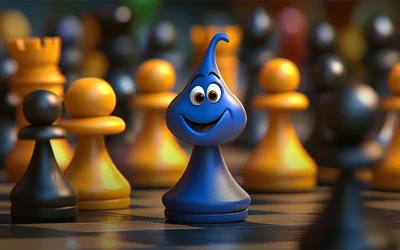
Evaluate before you Calculate!
Positional Insight is gained by applying 4 key Elements to a position. These are universal elements that will instantly improve your calculation process once fully grasped. Don't rush to calculate lines first aim to understand the situation.THE ELEMENTS ARE: 1. King Activity/Safety 2. Pawn Structure 3. Piece Activity (Center Control/Space) 4. Material
Chess is firstly positional before it is tactical, this is true as a foundational concept at its core. Tactically rich and creative play is produced through sound positional understanding. Masterpieces cannot create themselves but rather long term vision and the ability to coordinate your army effectively - CM Kenneth Willenberg
1.King Safety / King Activity (Short/Long term Vision of this element develops with practice until it becomes second nature)
In the opening/middlegame the king safety needs to be highly considered for obvious reasons, many pieces still being everywhere it's worth is reduced to defenselessness.
Endgames however require a high level consciousness around King activeness, centralized King (A King can be worth up to 4 tempi in endgame as a fighter piece!)
2.Pawn Structure
Pawns they say are The Soul of chess that gives the game it's frame and structure, weak Pawns become exposed in Endgames. Maintaining a good connected structure, claim space by advancing them. A pawn on the 7th rank about to promote is worth more than a mere 1point. Pass Pawns potential, setup pawn breaks. Think endgame always with Pawns placement.
3.Piece Activity / Comparing piece power
Literally question every pieces impact on a position, its opportunities for creating play. Compare every piece against your opponents to find the true worth of each piece and it's participation in the battle.
4. Material (Beginners - Intermediate level players place higher importance on material whereas mastering the game reveals how chess is less about concrete material and more about effectiveness of a piece in a given situation and it's dynamics)
Compensation over material
Activity and Space and development are factors that can distort value. A bishop can be Actively better than a Rook or a Knight and Rook can outplay a Queen given the aforementioned elements.
Thus material placed as the last element to assessment of positions in order to find ideas all of this should become second nature when analyzing. Play for the positional value and you'll create rich exciting positions with well coordinated plans.
How to Improve Your Evaluation Skills:
Practice:
Analyze games, both your own and those of stronger players, paying attention to how positions are evaluated
Study:
Learn about common chess themes and strategic ideas, such as pawn structure weaknesses, king safety, and piece activity.
Use Chess Engines:
Use chess engines to analyze positions and compare your evaluations to those of the engine.
HOW DO GMs DO IT (Universality of Method) GMs are just good at doing it effectively and quickly.
Grandmasters (GMs) evaluate chess positions by quickly assessing material balance, king safety, piece activity, center control, and pawn structure integrity, prioritizing these factors to determine the overall advantage or disadvantage in a given position.
Here's a more detailed breakdown of how GMs evaluate positions:
Material Balance:
GMs quickly gauge the relative value of the pieces, considering the total material advantage or disadvantage for each side.
King Safety:
They assess the vulnerability of each king, as a weak king can be a major weakness in the position.
Piece Activity:
GMs prioritize the activity of their pieces, ensuring that each piece contributes effectively to the overall strategy.
Center Control:
GMs evaluate the control of the center of the board, as it is a crucial area for piece activity and pawn structure.
Pawn Structure:
GMs focus on pawn formations, looking for strengths and weaknesses that might affect the outcome of the game.
Time Management:
GMs factor in time management and clock pressure, which can influence their decision-making during a game.
Plan:
GMs evaluate the board in terms of their current plan and the moves that further that plan.
Forcing Moves:
They consider moves that checkmate, threaten checkmate, win material, threaten to win material, give check, or force a response.
You may also like
 FM MathiCasa
FM MathiCasaChess Football: A Fun and Creative Variant
Where chess pieces become "players" and the traditional chessboard turns into a soccer field mullerrj
mullerrjAttack or be attacked
“Only the player with the initiative has the right to attack.” — Wilhelm Steinitz NDpatzer
NDpatzerScience of Chess: What makes a move seem "Brilliant?"
Sometimes a chess move warrants not just one, but two exclamation points - but what makes us call a … GM Avetik_ChessMood
GM Avetik_ChessMood10 Things to Give Up to Enjoy Chess Fully
Discover how embracing a lighter mindset can help you enjoy chess again and achieve better results. KSW2025
KSW2025